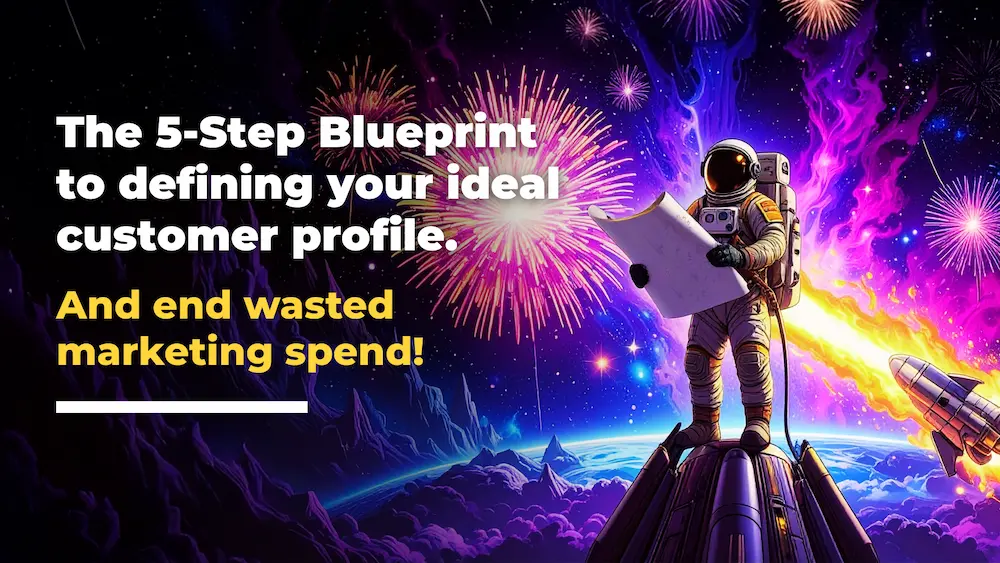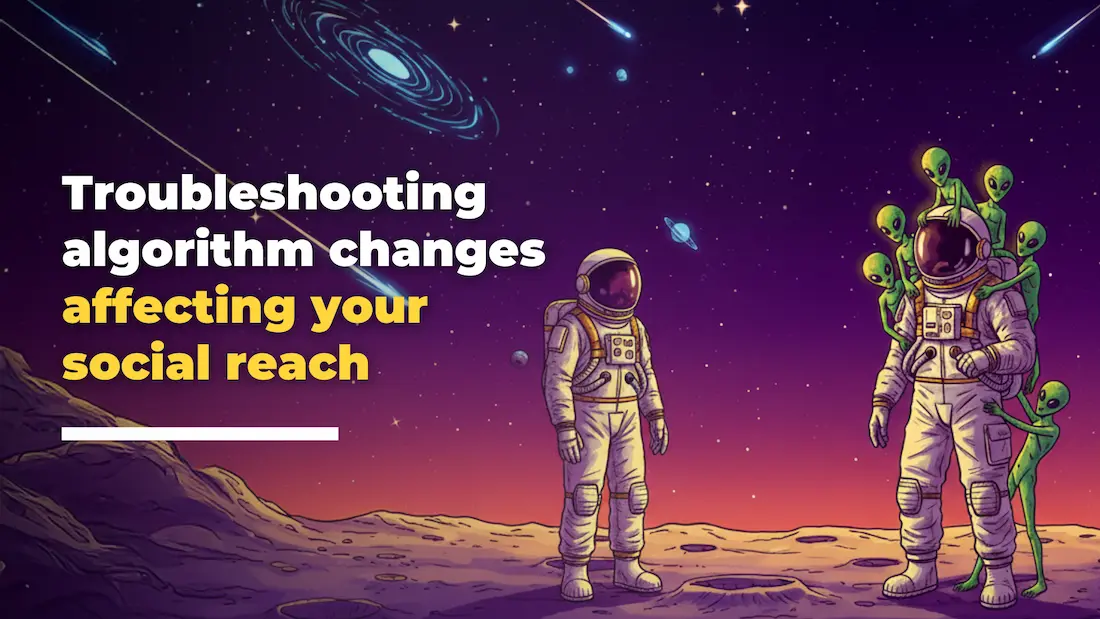Is your marketing budget disappearing with little to show for it? Are you spending your days on sales calls with prospects who are a terrible fit (they don’t have the budget, don’t see the value, or simply aren’t facing the problems you solve)?
If you’re nodding along, you’re not alone. Most founders and business leaders are trapped in a cycle of what we call “random acts of marketing.” You cast a wide net, hoping to catch something, but you end up with a trickle of low-quality leads and a deep sense of frustration. It feels like you’re playing a slot machine with your time and money, and it’s burning you out.
The root of this problem isn’t your work ethic or your passion. It’s that your marketing lacks a target. You’re trying to speak to everyone, and as a result, your message resonates with no one.
What if you could replace that guesswork with a clear, strategic focus? What if you could build a marketing system that magnetically attracts high-value, perfect-fit customers? You can. The secret weapon is a clearly defined Ideal Customer Profile (ICP). This isn’t just another piece of marketing jargon; it’s the foundational blueprint for efficient, profitable growth.
This guide will provide you with a simple, five-step blueprint to build your ultimate ICP and finally put an end to wasted marketing spend.
First, Let’s Get Clear: ICP vs. Buyer Persona
Before we dive into the blueprint, it’s critical to clear up a common point of confusion. Many people use “Ideal Customer Profile” and “Buyer Persona” interchangeably, but they are two distinct and equally important tools.
Think of it like this:
- An Ideal Customer Profile (ICP) describes the perfect company or organization to sell to. It’s defined by “firmographics”, objective, quantifiable data like industry, company size, revenue, and location. Your ICP is the filter that tells you which ponds to fish in.
- A Buyer Persona describes the different people within those ideal companies that you need to influence. It’s defined by “demographics” and “psychographics”, their job title, goals, challenges, and motivations. Your personas tell you what kind of bait to use for the different fish in the pond.
You need both, but the ICP always comes first. You can’t reach the right person if you’re targeting the wrong company. Our blueprint focuses on building that foundational ICP.
The 5-Step Blueprint for Building Your Ultimate ICP
Step 1: Analyze Your “Best” Existing Customers
The fastest path to finding more of your ideal customers is to look at the ones you already have. Your current customer list contains a goldmine of data waiting to be analyzed. But the key is to focus only on the best ones.
The “Why”: Not all revenue is good revenue. Some clients drain your resources, haggle on price, and are a constant source of stress. Your “best” customers, on the other hand, are a joy to work with. They see your value, get incredible results, pay on time, and become your biggest advocates. These are the clients you want to clone.
Your Action Step: Make a list of your top 5-10 favourite customers. Don’t just sort by revenue. Define “best” based on a mix of factors:
- Profitability: Who are your most profitable clients?
- Customer Success: Who has gotten the most significant results from your product or service?
- Relationship: Who do you have the best working relationship with? Who trusts your guidance?
- Growth Potential: Who has the most potential for future growth and a long-term partnership?
- Advocacy: Who is most likely to give you a glowing testimonial or refer new business?
This curated list is the raw material for the rest of your blueprint.
Step 2: Identify Common Firmographic & Quantitative Attributes
With your list of best customers in hand, it’s time to become a data detective. Your goal in this step is to identify the objective, quantifiable patterns that these ideal organizations share.
The “Why”: This data gives you a clear, black-and-white picture of the types of companies that are predisposed to succeed with you. These firmographics will become the primary filters for your sales and marketing efforts, ensuring you’re focusing your resources on high-potential prospects from the very beginning.
Your Action Step: Create a simple spreadsheet. List your best customers in the first column. In the subsequent columns, fill in the following data points for each one. Look for the patterns.
- Industry/Vertical: What specific industry are they in? (e.g., Clinics, B2B SaaS, Home Services). Be as specific as possible.
- Company Size: How large are they? Track this by both annual revenue and number of employees.
- Geography: Where are they located? (e.g., Victoria BC, Pacific Northwest, Canada-wide).
- Budget: What is their typical budget for a solution like yours?
- Structure: Are they a founder-led business? Do they have a dedicated marketing department?
- Technology: What other software or technology do they commonly use? (This can be useful for integrations and targeted advertising).
By the end of this step, you should see clear trends emerging. For example, you might discover that your ideal customer is a Canadian SaaS company with 20-50 employees and $5-10M in annual revenue.
Step 3: Uncover the Qualitative & “Human” Data
The data from Step 2 tells you what your ideal customers look like. This step is about understanding who they are and why they buy. This is where you move beyond the numbers to uncover the human story.
The “Why”: Logic makes people think, but emotion makes them act. Your marketing message will only resonate if it speaks directly to the real-world pains and aspirations of the people inside these companies. This qualitative data is what fuels compelling copy, relevant content, and effective sales conversations.
Your Action Step: Your goal is to understand the context behind their decision to work with you. You can gather this information by interviewing your best customers directly or by talking to your sales and customer service teams. Uncover the common answers to these questions:
- The Triggering Event: What was happening in their business that made them realize they needed a solution like yours?
- The Core Pain Point: What specific frustration were they experiencing? Don’t settle for surface-level answers. Dig deep to understand the emotional toll. (e.g., The pain isn’t “needing a new website”; it’s “the embarrassment of showing our outdated site to investors” or “the frustration of losing leads to our top competitor.”)
- The Desired Outcome: What positive future were they trying to achieve? What does success look like for them? (e.g., “predictable lead flow,” “the freedom to focus on the parts of the business I love.”)
- The “Watering Holes”: Where do they go for information and advice? (e.g., specific podcasts, LinkedIn influencers they follow, industry newsletters, conferences).
Step 4: Consolidate and Draft Your ICP Statement
Now it’s time to bring all your research together into a simple, clear, and usable document. An ICP isn’t a 20-page report; it should be a one-page summary that anyone in your company can understand and use.
The “Why”: Formalizing your ICP transforms it from a vague idea into a tangible strategic tool. This document becomes the single source of truth that aligns your entire organization around a shared vision of your best customer.
Your Action Step: Create a one-page document with the following sections:
- ICP Title: Give it a descriptive name (e.g., “The Growth-Focused Canadian Tech Founder”).
- Summary: A short paragraph that tells the story of this company.
- Firmographics (Quantitative Data):
- Industry:
- Company Size (Employees & Revenue):
- Location:
- Budget:
- Qualitative Profile (Human Data):
- Common Pains & Frustrations:
- Desired Goals & Outcomes:
- Common “Watering Holes”:
- Red Flags (Your “Anti-ICP”): It’s just as important to define who you are not a good fit for. This helps your sales team disqualify poor-fit leads quickly. (e.g., “Companies looking for the cheapest option,” “Businesses with no internal champion for the project,” “Those who want a quick fix instead of a long-term strategy.”)
Step 5: Activate and Integrate Your ICP Across the Business
An ICP document that sits in a Google Drive folder is worthless. The final, most critical step is to actively embed this profile into the daily operations of your business.
The “Why”: Your ICP is a powerful decision-making filter. When fully integrated, it ensures that every department is aligned, moving in the same direction, and focused on serving your most valuable customers.
Your Action Step: Schedule a meeting with your entire team to present the new, finalized ICP. Then, brainstorm how each department will use it:
- Marketing: Will use the ICP to refine ad targeting, choose content topics that address core pain points, and distribute content in the right “watering holes.”
- Sales: Will use the ICP to score and qualify leads, disqualify poor fits early, and tailor their discovery questions and demos to what matters most.
- Product/Service: Will use the ICP’s pains and goals to inform new feature development or service offerings, ensuring you’re building what your best customers actually need.
- Customer Success: Will use the ICP to better understand customer goals, leading to higher satisfaction and retention.
From Random Acts to a Strategic System
Defining your Ideal Customer Profile is the single most impactful strategic exercise you can undertake. It’s the foundational step in moving from a state of chaotic, reactive marketing to a calm, confident, and proactive growth system. It’s the map that guides every decision you make, ensuring that your time, money, and energy are all focused on attracting and delighting the customers who will propel your business forward.
Ready to build a marketing system that magnetically attracts your ideal customers? Let’s talk.





